Pretty Big for a Stowaway
We were surprised at the response we received to our recent review of the Knox Ricochet back protector.
We didn’t expect that so many motorcycle riders would be interested in such a serious piece of safety equipment.
But we should have known better!
After all, webBikeWorld visitors are the smartest and most discerning motorcyclists in the world, right?
Smarter than us, actually — we didn’t even know that the Ricochet model that we received wasn’t the Stowaway that we originally ordered.
A webBikeWorld visitor tipped us off on that one.
So now we have a Knox Stowaway, along with a Knox Cross Sport Short (say that ten times fast!) and a Knox Cross Shirt to review.
Armor or Protectors?
Calling this stuff “armor” rather than “protectors” seems a bit silly.
But, Knox says that both of these products are “wearable armor”.
That is, they have a full set of armor in a generously perforated undershirt and underpants, and can be worn under just about any type of motorcycle outerwear.
More on those in an upcoming review, but for now, let’s focus on the Stowaway back protector
Where to Buy Knox Stowaway Back Protector
Also Shop for: Motorcycle Jackets, Motorcycle Gloves, Motorcycle Boots, Motorcycle Pants
The Knox Stowaway
The Knox Stowaway is lighter and thinner than the Ricochet, and it’s hard to compare how much protection it might offer in comparison, but it does feel more comfortable to wear.
The Stowaway weighs only 1.2 lbs., (544 grams), which is just about half of the Ricochet’s 2.2 lbs. (1 kg).
We didn’t really notice the weight of the Ricochet, because the mass is spread across the rider’s back, but the Stowaway definitely seems less noticeable in use.
Something else that definitely adds to the comfort factor is so simple, we should have thought of it. Chalk it up to being back protector rookies, but here’s a tip sent to us by Jan Mindar, the Export Development Director for Planet Knox in the U.K.:
Jan suggested we cross the shoulder straps in the front for a better fit.
This completely cures the problem that we had with the Ricochet — we couldn’t get the un-crossed shoulder straps tight enough to make the product feel comfortable.
Crossing the straps in front really makes a difference, because it pulls the protector nice and tight up against the rider’s back, preventing it from shifting around.
This makes the protector feel more like it’s part of me, rather than like a piece of plywood hanging off my back.
Jan also responded to our concern over the stiffness of the back padding on the Ricochet. She wrote:
“Basically there is no need for a great deal of padding by virtue of the effectiveness of the protector. In order for a back protector to achieve CE accreditation (for Level 1), the maximum force which it can transmit is less than or equal to 18 kilonewtons. The Ricochet performs well within this standard, transmitting only 10 kilonewtons in the test.
So padding does not equal protection! Damage will be minimised if a rider has an accident wearing a back protector and our protectors will certainly not cause any damage – where as some protectors which have rivets on the inside may well do as these rivets could pop out.
The Ricochet was developed with comfort in mind as well as safety and so a thin padding was added to keep the rider cool and enable the protector to be worn under tight fitting leathers.
Additionally, the lining also has spacers which lift the protector away from the body, allowing ventilation as this was a major area which riders highlighted as a priority.
Another thing to note is that the more the protector is worn, the more comfortable it becomes, as the rubberised areas mould more closely to the shape of the rider’s body. I think it is also fair to comment that an individual should choose the protector which feels most comfortable – some people prefer our Contour model to the Ricochet, so it really is ‘horses for courses’.”
Interesting! By the way, I’m not a physicist, but a Newton, named for Sir Isaac, is “the amount of force required to accelerate a mass of one kilogram at a rate of one meter per second square.” Multiply that 2.2 times 100, and you have a kilonewton (224.9 lbs-force).
Apparently, the CE specs allow a lot of force!
If the CE level 1 accreditation calls for no more than 18 kN (4,046 lbs. force), then the Ricochet, at 10 kN, transmits 2,250 lbs. of force.
I’m not sure if the force is measured at a single point, or if the design of the back protector then spreads that force out over a wide surface area, diminishing its effects on the body.
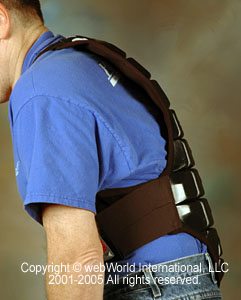
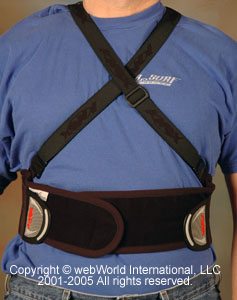
Jan also sent us some good information on what to look for and how to choose a back protector:
“We have three back protectors in the Knox range – the Ricochet, the Stowaway and the Contour – all designed with different usages in mind. The Ricochet is suitable for the sports, adventure sport, cruiser and commuter markets; whilst the Stowaway is suitable for most categories apart from sports.
The Contour is our newest product which which offers … the highest level of safety and is designed with the sports and adventure sports markets in mind. At Knox we place the emphasis on getting the right protector for you and your rider category. So it is important that the protector covers your spine and you should be measured for this. Then you should try the protector for comfort – if it feels good then you will wear it!
It is also important to get the right protector for your rid(ing) position – so choose the product which is designed for your ride. If you get the size and fit right, your armour will soon become a regular piece of your kit and the more you wear it the better it feels as it moulds to the shape of your body.
Always buy armour that is certified as ‘CE approved’, as this means it has been tested and conformed to relevant specifications – watch out for equipment which says it is ‘made to European CE standards’ as this won’t have been tested in an approved testing house!
Any CE approved items will carry an information booklet detailing which test house approved the item, what purpose it should be used for, which standards the product conforms to and care instructions – again watch out for products which don’t carry this as they aren’t CE approved!”
Where to Buy Knox Stowaway Back Protector
Also Shop for: Motorcycle Jackets, Motorcycle Gloves, Motorcycle Boots, Motorcycle Pants
Construction
The fabric and the construction used in the Stowaway is different than the Ricochet.
Where the Ricochet’s padding felt stiff, the padding on the Stowaway has more give, although we wouldn’t call it plush. The fabric on the inside (i.e., the side worn towards the rider) is soft and has some give.
A visitor wrote with an interesting opinion on why the padding on back protectors is stiff, see theOwner Comments section of the Ricochet article for more.
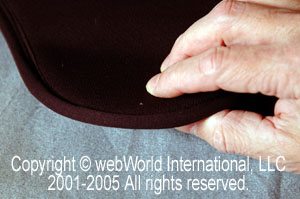
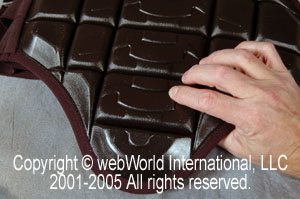
We really don’t have any problems fitting the thicker Ricochet under our motorcycle clothing, and the Stowaway is even thinner and less noticeable.
See the photo below, which illustrates the Stowaway worn under the Olympia Vortech perforated leather jacket.
By the way, in addition to our upcoming evaluation of the Knox Cross Sport “wearable armor”, we’re in the process of evaluating a couple of one-piece leather suits.
The Knox products work very nicely under those suits and offer about the maximum protection possible with today’s technology. Stay tuned for more…
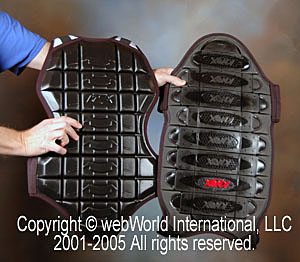
The photo above illustrates the size of the Stowaway back protector (on the left in the photo) to the Ricochet.
As you can see, there isn’t much difference in surface area, and in fact, the Stowaway has a wider wrap-around section that has the potential of offering greater protection to the rider’s sides.
The Stowaway (and the Ricochet) both use Coolmax fabric that’s anti-bacterial treated to prevent mildew.
Conclusion
We’re getting used to wearing our back protectors during every ride.
Although the amount time required to suit up is directly correlated to the amount of protection the rider is wearing, throwing on a back protector only takes seconds.
The human spine is an incredible piece of work and it’s also very fragile, so it’s well worth protecting!
By the way, our Stowaway did come with a nice storage bag.
More webBikeWorld:
| wBW Review: Knox Stowaway Back Protector | |
|---|---|
| Manufacturer: Knox Armor | List Price (2005): $159.00 (£59.99) |
| Colors: Black | Made In: Unknown |
| Review Date: November 2005 | |
Note: Item provided by a retailer, distributor or manufacturer with these Terms and Conditions.
Where to Buy Knox Stowaway Back Protector
Also Shop for: Motorcycle Jackets, Motorcycle Gloves, Motorcycle Boots, Motorcycle Pants
Owner Comments and Feedback
See details on submitting comments.
From “N.”: “I think the biggest “advantage” of the Ricochet is it’s multiple-impact absorbing abilities, which is first for Knox, as the inner energy absorbing material is a plastic honeycomb.
I think they switched from a polypropylene material to a high density polyethylene core, but I’m not sure. I’ve got limited knowledge of these materials as they are used in various applications.
The basic advantage of the Stowaway is the convenience factor, it can be rolled-up and stored in the bag when you are not on the bike and in your gear. It’s a one-time use piece, with the older plastic honeycomb material.
They both achieve Level 1 CE approval. There are others out there that achieve level 2 passes that I’m interested in seeing reviewed for comfort.
One is Knox’s new Contour model, the other is the more readily available T-pro Forcefield, which is now also being sold by Joe Rocket as the Speedmaster protector. The T-pro uses a foam-rubber material that’s pretty impressive, and seems really flexible.”

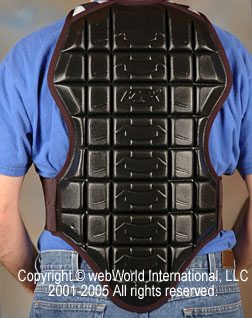

No Comment